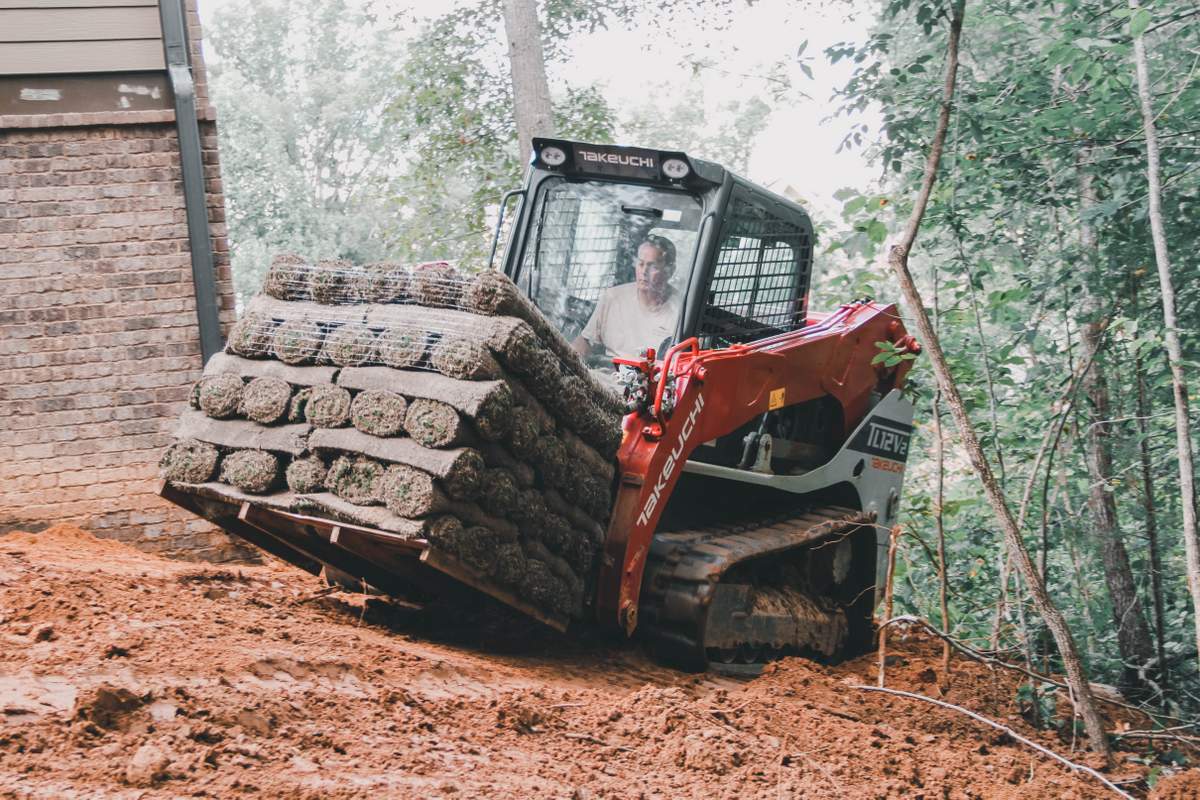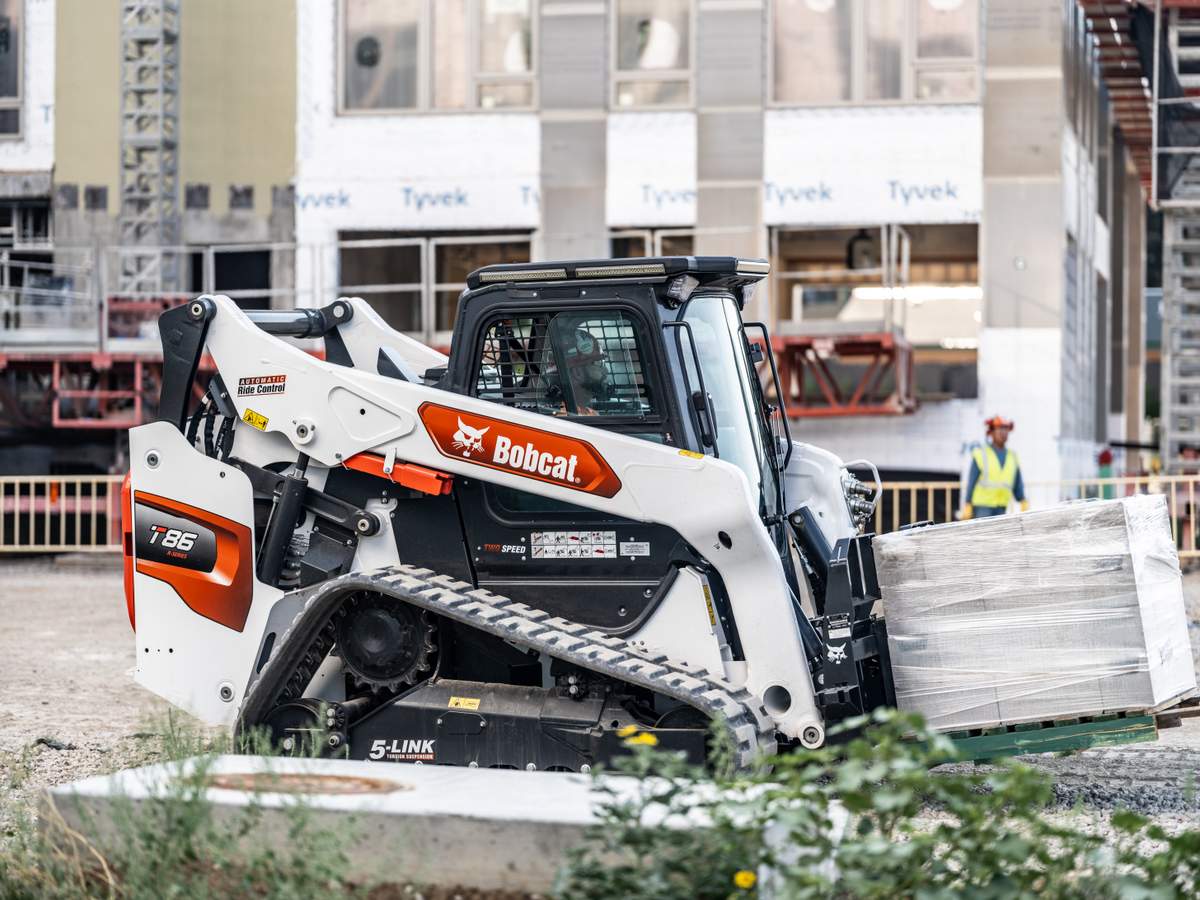The Art of CTC Attachments
Over the years, compact tool carriers (CTCs) have caused quite a stir when it came to the name game. Are they mini track loaders or mini skid steers? Compact utility loaders? While different manufacturers prefer different titles, one fact has always remained true despite the many aliases — these small workhorses offer big productivity on construction and landscaping sites.
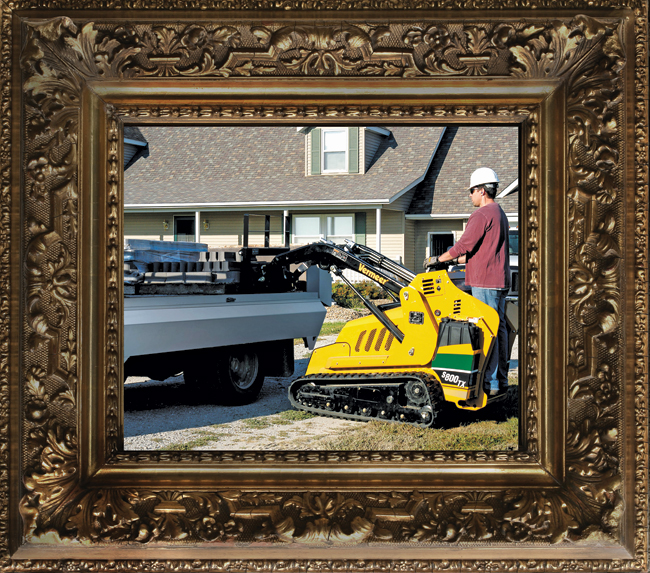
Thanks to a universal attachment plate, a CTC can couple with any number of attachments — from breakers and trenchers to backhoes and brooms — to offer operators the perfect solution to their project needs. Over the next four pages, we dissect eight of the most popular attachments used on jobsites every day. Take a look at their applications, specs and pricing and discover what implement will best work for you.
Pam Kleineke is associate editor of Compact Equipment, based in Peninsula, Ohio.
Diggin’ It
Augers Allow Crews to Dig and Avoid Backbreaking Labor
When a project calls for digging holes anywhere from 4 to 36 in., an auger attachment works wonders with a CTC. Eliminating the need for a shovel (and the labor it takes to dig), the auger simply attaches to the machine, spins its way into the ground and removes excess dirt.
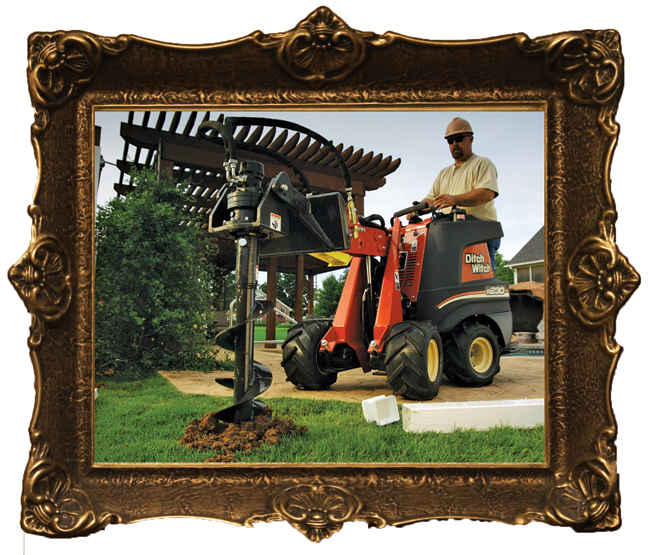
“An auger is a great attachment to have because it can be utilized in many applications,” says Jon Kuyers, product manager for underground solutions at Vermeer Corp. “It can be used to install posts in the ground, such as a fence, a foundation for a structure or planting a tree.”
When selecting an auger, there are different options depending on bit styles and sizes which range from 4 to 36 in. Kuyers points out that flat bottom bits provide a square bottom hole, and tapered bits give a slight angle to the hole which is ideal for planting trees. Rock auger bits are designed to withstand more abuse, making them perfect for rocky conditions.
Matt Collins, compact equipment product manager for Ditch Witch, mentions that when working with a CTC, an operator must match the auger driver flow and gallons per minute (gpm) to the specifications of the unit. Most CTCs require 10 to 14 gpm to properly operate the attachment.
There are also two types of auger drives: high speed/low torque and low speed/high torque. Kuyers says that high speed/low torque is used for digging holes less than 12 in. in good ground conditions. Low speed/high torque is used in harder ground conditions for more digging power or to install anything from 12 to 36 in.
If you’re looking to include an auger in your fleet, this attachment typically ranges from $2,000 to $3,500, depending on size and drive. Rental is also a great option and will set a customer back around $40 to $60 a day.
Expert Excavator
Connect with a Backhoe to Add Digging Duties to Your Job Portfolio
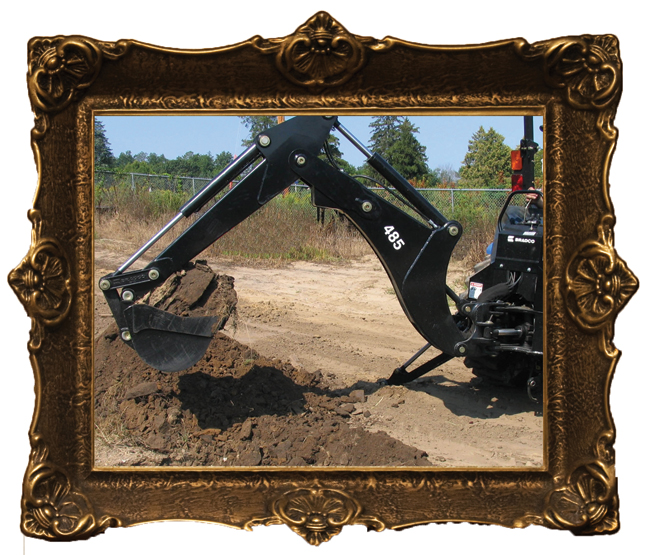
Contractors can get big excavating power with a small package when adding a backhoe attachment to their CTC fleets. This versatile implement transforms the CTC into a digging machine for tasks such as water hookups, concrete footings and tile lines. Dave Aldrich, light construction dealer development and service manager for Paladin Construction Group, explains that backhoe attachments help save time and money.
“These attachments require less transportation cost, both in expense and time, and less investment than a conventional tractor loader backhoe or mini excavator,” he says.
Backhoe attachments are available in a variety of sizes to accommodate project requirements. Typical dig depths range from 6 to 12 ft, and hydraulic requirements for a backhoe range from 7 to 14 gpm, depending on the size of the backhoe.
“When purchasing a backhoe attachment, it’s important to look for features that are similar to what you would find on a full-size tractor loader backhoe,” says Aldrich. “For example, look for attachments that feature cushion cylinders, swing speed control, a 180-degree swing range and a 180-degree bucket rotation with assorted bucket sizes available.”
While the features above are important, it’s imperative to properly match the size of the attachment to the CTC. Collins says to make sure that both the attachment and the machine are within their operating tolerances. For example, if an operator is using a backhoe attachment that is too big for his or her CTC, they can accelerate the wear and tear of the machine — taking years off its life. A backhoe attachment can cost anywhere from $7,500 to $14,000, depending on its size and features. Rental options typically run $80 to $300 per day.
Site Seeing
Box Rakes Lend a Hand in Clearing and Leveling Land
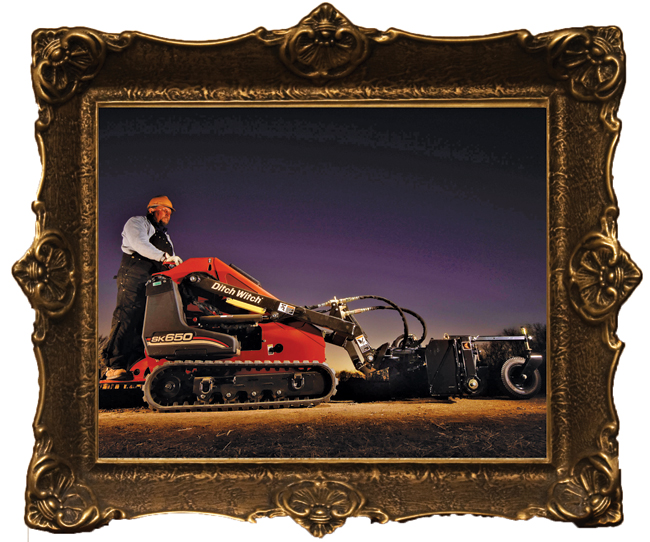
Box rakes are an ideal attachment to clean, level and prep jobsites. Construction professionals can use them to tidy up by sorting rocks and other debris so they can level the land prior to starting a project. Landscapers find box rakes useful so they can smooth out the earth and loosen up soil for sod or seed.
The hydraulic requirements for most CTCs to run a box rake are 10 to 14 gpm. However, Justin Odegaard, attachment product specialist for Bobcat Co., points out machines that boast higher hydraulic horsepower provide additional drum torque, which offers better performance in hardpack or clay soils and allow for deeper soil penetration. He also suggests looking at whether or not the unit has a manual or hydraulic angle and depth controls. “Both of these allow the operator to make changes on the fly to direct spoil where it’s wanted or lower the depth briefly in areas that need a little more conditioning,” he says. “These features also make the attachment much more versatile when sculpting the landscape.”
When operating a box rake, Collins mentions that the attachment itself is multi-directional, meaning the attachment and unit will work together on the direction you travel. “On Ditch Witch units, you lower the attachment loader arms with the rake taking a ‘bite’ out the ground at no more than 1 to 2 in. of depth at a time,” he says. “The ground conditions will determine the proper depth. Taking too big of a bite [of the ground] will result in the unit and/or the attachment stalling out. Once the proper depth is found, simply move the unit back and forth to make a smooth, level surface.”
Most box rakes come in 48-in. widths and can cost about $5,000 to $7,500. Daily rental rates range from $60 to $100.
Break It Down
Breaker Attachments Smash Through Tough Materials to Get the Job Done
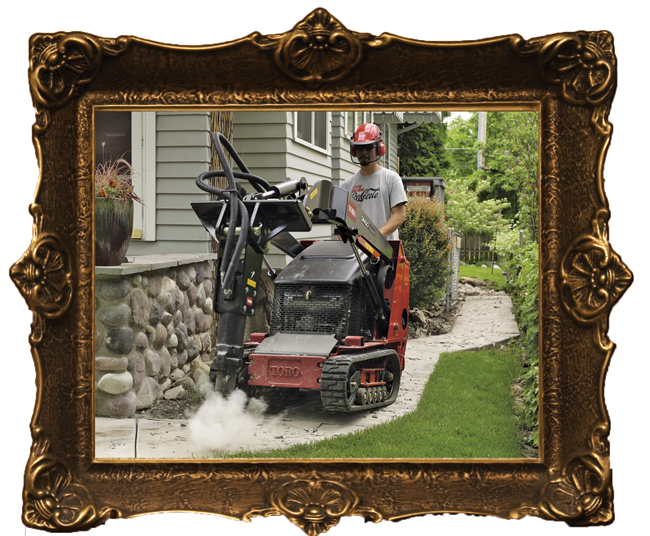
Sometimes a contractor’s job doesn’t involve building, but rather tearing something apart. In times when a project calls for demolition (such as breaking out driveways, sidewalks and patios), a breaker or hammer attachment (same thing, different name) is the right fit. These attachments are ideal for hardscaping applications and are convenient thanks to the small size of the CTC. Since a contractor can achieve great demo results from a compact machine, breaker attachments make work easier in tight areas and in or around homes.
Like all breakers, CTC-mounted units are rated by impact energy in ft-lbs, ranging from 150 to 300 ft-lbs. The higher the class of the breaker, the more flow and pressure will be required from the hydraulic system. Concrete breakers are also measured in blows per minute (bpm). A typical CTC hammer will deliver 175 ft-lbs of force, using 1,200 bpm to break materials to a depth of 11 in. The breakers run off the unit’s hydraulic system, usually with flow ranges from 4 to 10 gpm or 9 to 16 gpm to hammer away on the jobsite, ranging in cost from $6,000 to $11,000.
After adding a breaker to your fleet, Kuyers offers up some operational advice to keep the attachment working properly and staying productive. “Make sure the breaker is engaged on material,” he says. “The worst thing you can do with a hydraulic breaker is to dry-fire it, which is to engage the hydraulics to the hammer without engaging any material. If the energy transmitted from the breaker isn’t absorbed, then the reciprocating force will cause internal damage to the attachment.”
Swept Away
Cleanup Is a Cinch with Dutiful Broom Attachments
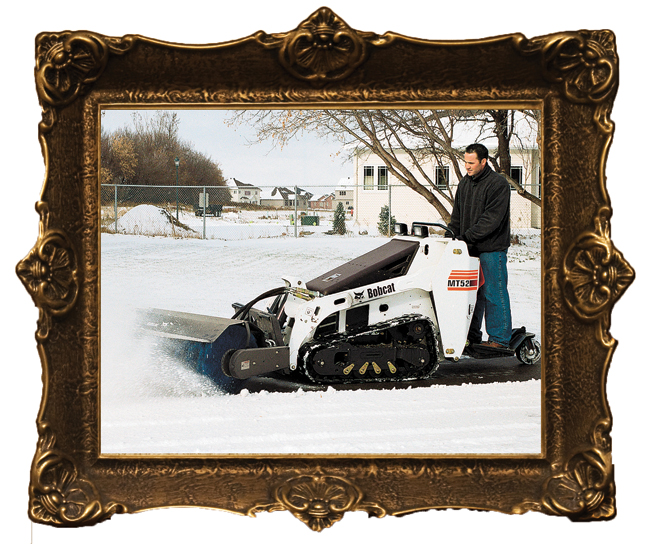
Cleanup is made easy thanks to the addition of a broom attachment. There are two types of brooms available for a CTC — an angle broom and sweeper. Odegaard says that a hydraulically-driven angle broom can clear away dirt, dried mud, light snow and other debris from driveways, sidewalks, parking lots, loading docks and warehouses easily and efficiently.
Angle brooms have bristles that boast a waved design, delivering more surface clearing ability which can clear a cleaner path and more snow or debris in one pass. Sweepers can sweep, collect and dump dirt and other debris. Odegaard points out that these attachments are ideal for construction, industrial and municipal jobs. Sweepers are also easy to attach and simple to operate going either forward or reverse.
“The floating bristle head [of a sweeper] follows surface contours independently of the bucket, providing optimum surface contact even while operating on uneven terrain and slopes,” he says. “The floating head also offers ideal down-pressure for longer bristle life, reducing the number of required bristle adjustments.”
Size options for angle brooms include 48, 68 and 84 in. Sweeper attachments are available in 36-, 44-, 48-, 54-, 60-, 72- and 84-in. widths. A sweeper operates between 145 and 215 rpm at 15 gpm, depending on the size of the attachment. The purchase prices for angle brooms range from $3,000 to $6,000, and sweeper brooms cost $3,000 to $4,500. The prices vary depending on the size of the attachment and machine it’s being matched with.
Buckets O’ Productivity
Scoop, Carry and Place Materials Easily

The most used attachment on a CTC (and other tool carriers) is a bucket. This go-to implement is perfect for moving dirt, rock, mulch and just about anything that needs to be transported from one area to another. However, there are a few options to choose from when it comes to selecting a bucket. Here, Kuyers breaks down the different styles available to contractors and landscapers:
• A standard bucket is an all-purpose bucket for general loads, such as dirt and rock.
• High-capacity buckets are designed to carry a greater capacity of lighter material, such as mulch.
• A 4-in-1 bucket is quite versatile and can be used in various applications. Besides loading, it can help back drag or level out ground. It also has hydraulics to function like a jaw attachment and grab rocks.
• Rock buckets are used to carry only rocks and typically allow smaller material to fall through. These buckets are ideal when you only need to move the big items out and leave the soil behind.
• An excavator bucket has teeth in order to dig into tough ground.
• Narrow buckets are less than 42 in. wide and are ideal for tight spaces around residential homes and yards.
If a bucket fits the bill for your project needs, retail pricing ranges from $600 up to $2,500, depending on what style is preferred.
Back to the Grind
Get Things Moving with the Addition of a Stump Grinder
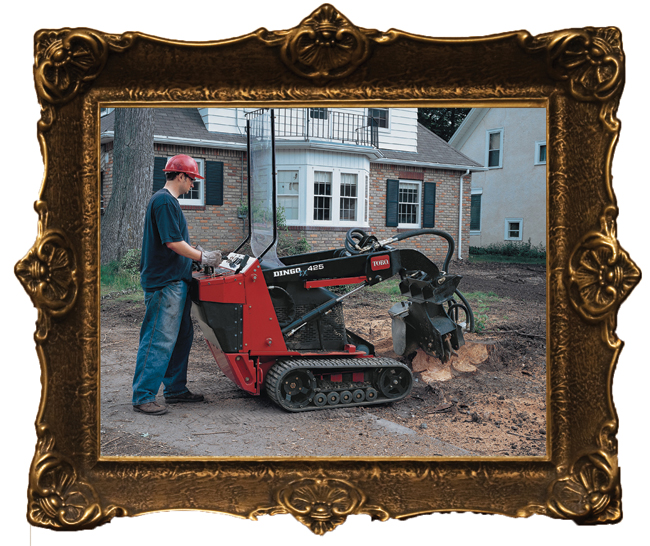
Some projects can’t begin until there’s a clean slate, and that’s where a stump grinder attachment can come in handy.
“Proper removal of stumps and their roots is crucial to the outcome of many construction and landscape projects,” says Aldrich. “A stump grinder attachment allows you to cut below grade to reach the base of the roots. This allows you to fill in the area with dirt so grass or other vegetation has a chance to grow, or if pouring concrete or another type of surface. The ground can be compacted so that it eliminates settling.”
Stump grinder attachments come in a variety of sizes. For example, Bradco offers a 26-in. model for standard-flow hydraulic systems and a 30-in. model for high-flow hydraulic systems. Greg Lawrence, marketing product manager at The Toro Co., says that Toro’s stump grinder features a 17-in. cutter wheel with 12 cutting teeth. Typical wheel speeds range from 1,900 to 2,050 rpm with a tooth speed between 140 to 180 ft per second.
Different types of stump grinder attachment teeth are available to best suit the needs of the operator. “A multi-directional tooth pattern permits cutting from side to side and vertically,” explains Aldrich. “Optional square-threaded, single-bolt teeth or shark-style, universal, bolt-on teeth are available for varying cutting conditions.”
When looking to purchase a stump grinder, you can expect prices to range from $3,500 to $10,000, depending on the size and tooth pattern of the attachment. Rental prices are around $100 to $300 a day.
In the Trenches
Create the Perfect Place for Utilities with a Trencher Attachment
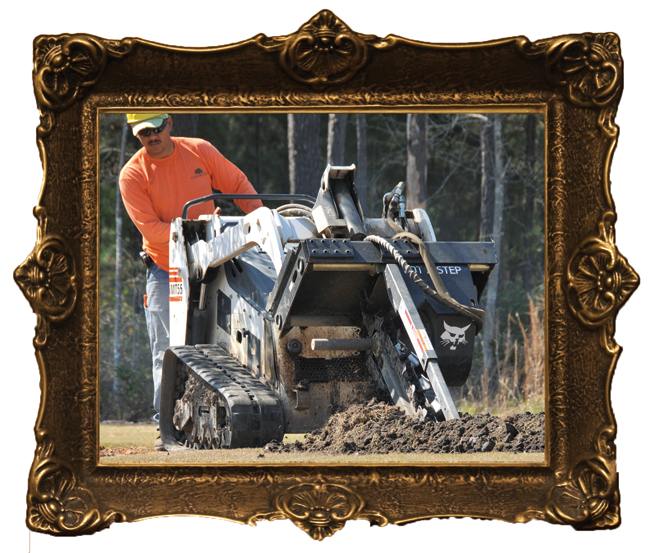
Versatile CTCs can become trenching machines with the quick addition of a trencher attachment. By adding one of these hard-working implements, an operator can carve out a slice of earth and make way for the installation of utilities and other underground tasks.
“One of the biggest reasons trencher attachments are so popular with construction and landscape professionals is because it stays with the theme of an attachment carrier — lower cost investment and increased utilization of the carrier,” says Odegaard. “Trencher attachments are capable of digging up to 5 ft in depth and up to 12 in. wide, allowing them to install almost any kind of underground utility.”
When pairing a trencher attachment to a CTC, the machine must have the hydraulic requirements of 10 gpm or higher. Odegaard says that the dig depth of a trencher is usually rated at around a 60-degree dig angle — the optimum angle for digging. Most trencher attachments are available in 4-, 6-, 8- and 12-in. widths.
Contractors need to consider the ground conditions they plan to dig in. Since soil conditions can vary, there are numerous types of digging chains available for the attachment. These specific chains can handle anything from light dirt or sand to very rocky soil or even coral, says Odegaard. A local dealer can help determine the best chain for an operator’s needs. Purchase prices for trenchers can range from about $2,500 to $10,000, depending on durability, performance and chain types needed. Rental is always an option and rates can range from around $100 to $200 a day.



